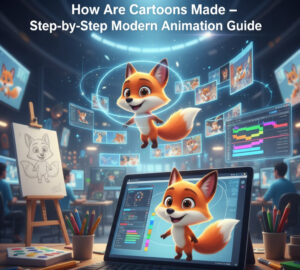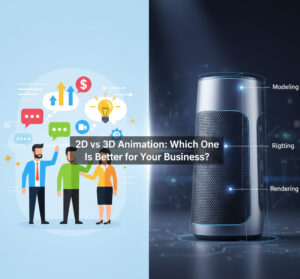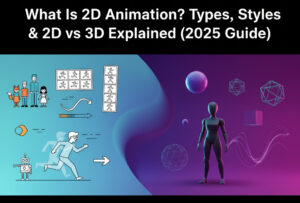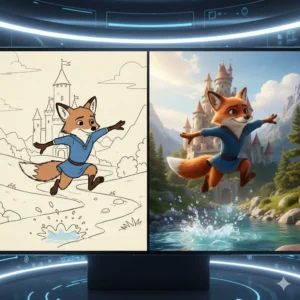Animation has come a long way from hand-drawn flipbooks to lifelike digital characters. Whether you’re an aspiring animator, a filmmaker, or simply curious about the craft, you’ve probably asked, “Which is easier to make, 2D or 3D animation?”
Both styles have their charm, complexity, and learning curves. In this guide, we’ll break down everything you need to know about 2D vs 3D animation, including the differences, examples, tools, and pros and cons, helping you decide which one suits your creative goals best.
What ‘s 2D Animation?
2D animation is the classic form of animation that involves creating characters, objects, and environments in a two-dimensional space with height and width but no depth. Think of timeless cartoons like Tom and Jerry or The Simpsons—that’s 2D animation in action.
In this technique, every frame is drawn manually or digitally, showing subtle changes in position or expression to create motion.
Key Features of 2D Animation:
- Uses flat drawings and vector graphics
- Movements rely on frame-by-frame changes
- Popular in cartoons, explainer videos, and marketing animations
What ‘s 3D Animation?
3D animation brings visuals to life in a three-dimensional space with height, width, and depth. Unlike 2D, this technique creates lifelike movement and realistic textures using digital modeling.
Movies like Toy Story, Frozen, and Avatar are outstanding examples of 3D animation at its finest. Instead of drawing each frame, animators build models in software like Blender or Maya, then rig and animate them to simulate real-world movement.
Key Features of 3D Animation:
- Involves digital modeling and rendering
- Creates lifelike visuals and depth
- Used in films, video games, architecture, and advertisements
Difference Between 2D and 3D Animation
Understanding the difference between 2D and 3D animation is crucial before choosing which one to pursue. Let’s break it down:
Aspect2D Animation 3D Animation Dimension Flat (height and width) Realistic (height, width, and depth) Creation Process Frame-by-frame drawing Modeling, rigging, texturing, lighting Software Toon Boom, Adobe Animate, OpenToonz, Blender, Maya, Cinema 4D, Unreal Engine Time Requirement Faster for simple projects It is longer due to rendering and details. Learning Curve Easier for beginners More complex and technical Visual Appeal Artistic, hand-drawn look Realistic and immersive Use Cases 2D games, explainer videos, cartoons Movies, games, commercials, simulations
In short, 2D animation is simpler and more artistic, while 3D animation is more detailed and technical.
2D vs. 3D Animation: Which Is Easier to Learn?
If you’re just starting, 2D animation is generally easier to learn and create. It requires basic drawing skills, an understanding of timing, and storytelling.
Meanwhile, 3D animation involves mastering multiple technical skills: modeling, rigging, texturing, lighting, and rendering. The software used for 3D animation can also be quite complex.
However, once you grasp the basics, 3D animation offers greater creative freedom and visual realism.
Verdict:
Easier to Learn: 2D Animation
More Advanced Potential: 3D Animation
2D vs. 3D animation examples.
Here are some iconic examples that showcase the beauty and differences between both styles:
Famous 2D Animation Examples
- Tom and Jerry —classic hand-drawn slapstick comedy
- The Lion King (1994)—Disney’s masterpiece using 2D animation techniques
- Adventure Time – Modern 2D with a unique art style
- Cuphead (Game)—1930s-style 2D video game animation
Famous 3D Animation Examples
- Toy Story —the world’s first 3D animated feature film
- Frozen has stunning 3D visuals and lifelike characters.
- Avatar—realistic motion capture combined with 3D modeling.
- Fortnite (Game)—Real-time 3D animation in gaming
These 2D vs 3D animation examples show that each style can be powerful depending on the storytelling approach.
2D vs 3D Animation: Advantages and Disadvantages
Let’s compare both styles in terms of pros and cons to help you decide which fits your needs better:
Advantages of 2D Animation
- It’s faster to produce for short projects.
- Less expensive to create and render
- It’s easier to learn for beginners.
- Stylized visuals perfect for explainer or educational videos
Disadvantages of 2D Animation
- Limited depth and realism
- Difficult to create dynamic camera angles
- Frame-by-frame drawing can be time-consuming.
Advantages of 3D Animation
- Highly realistic visuals with depth and lighting
- Flexible camera movement for cinematic effects
- Reusable models and rigs
- Ideal for films, games, and marketing visuals
Disadvantages of 3D Animation
- The rendering process is time-consuming.
- Requires powerful hardware and software
- Steeper learning curve for beginners
Which Is Better for beginners: 2D or 3D?
If you’re new to animation, 2D is the best place to start. It teaches you the foundations of movement, timing, and storytelling: essential skills for both 2D and 3D work.
Once you’re comfortable, transitioning to 3D becomes easier because the core animation principles remain the same.
However, if your goal is to work in game design, CGI, or film production, starting with 3D animation may save you time in the long run.
The best 2D AI Animation Software
Thanks to AI technology, animating in 2D has never been easier. Here are some top AI-powered 2D animation tools that can speed up your workflow:
- Animaker – Great for beginners; drag-and-drop interface with AI scene suggestions.
- Toon Boom Harmony: Industry standard for professional 2D animation studios.
- OpenToonz: Free and open-source, used by Studio Ghibli.
- Renderforest: AI-powered video creation tool for quick 2D animations.
- Vyond: Ideal for creating business explainer animations with AI automation.
If you’re looking for the best 2D AI animation software, start with tools that offer templates, motion presets, and character automation perfect for saving time and maintaining quality.
Anime 3D Animation vs 2D: The Modern Fusion
Anime has traditionally been 2D animation, defined by flat shading, expressive faces, and stylistic backgrounds. However, modern studios like MAPPA and Ufotable are blending 3D animation techniques with 2D aesthetics to create a hybrid look.
For example:
- Demon Slayer uses 3D camera movements combined with 2D character art.
- Attack on Titan integrates 3D Titans and environments for realism.
The fusion of 3D animation and 2D art in this anime provides smoother motion, dynamic perspectives, and faster production while maintaining the traditional anime feel.
Cost Comparison: 2D vs 3D Animation
Cost is a major factor when deciding between the two.
- 2D Animation: Typically cheaper because it doesn’t require expensive software or high-end computers.
- 3D Animation: Can be costly due to rendering, detailed modeling, and software licensing.
Average Cost Estimate:
- 2D Animation: $50–$300 per minute
- 3D Animation: $1,000–$5,000 per minute
(These vary based on complexity, studio, and region.)
Career Opportunities in 2D and 3D Animation
Both fields offer exciting job prospects:
2D Animation Careers
- Storyboard Artist
- Motion Graphics Designer
- Character Animator
- Visual Effects Artist
3D Animation Careers
- 3D Modeler
- Game Animator
- VFX Specialist
- Rigging or Lighting Artist
The demand for 3D animation professionals is growing rapidly in the gaming, VR, and film industries, but 2D animation continues to dominate online content and marketing.
Conclusion: Which Is Easier to make—2D or 3D Animation?
So, which is easier to make, 2D or 3D animation?
If you prioritize simplicity, creativity, and a reduced learning curve, 2D animation emerges as the superior choice. It’s more accessible for beginners, affordable, and perfect for storytelling-based projects.
However, 3D animation, with its realism, complex visuals, and cinematic effects, justifies the effort and investment.
In the end, both styles have their own artistic and professional value. The best choice depends on your goals, skills, and passion.
Final Verdict:
- 2D Animation Easier, artistic, and ideal for beginners and storytellers.
- 3D animation is advanced, realistic, and perfect for games and films.
Whichever path you choose, the world of animation is full of opportunities, and with today’s AI-powered tools, bringing your imagination to life has never been easier.
FAQs
Q1: What is the main difference between 2D and 3D animation?
A: The main difference lies in dimension—2D animation is flat with height and width, while 3D animation adds depth, creating a realistic, three-dimensional look.
Q2: Which is easier to learn, 2D or 3D animation?
A: 2D animation is generally easier for beginners because it focuses on drawing, timing, and storytelling, while 3D animation requires mastering complex tools and techniques.
Q3: Which animation style is more affordable to create?
A: 2D animation is typically more affordable, as it needs less rendering power and simpler software compared to the high-end tools used in 3D animation.
Q4: What are the advantages of 3D animation over 2D?
A: 3D animation offers realistic visuals, flexible camera angles, and reusable models, making it ideal for movies, games, and immersive experiences.
Q5: Can anime be made in 3D animation?
A: Yes, many modern anime series use a blend of 2D and 3D animation techniques to achieve smoother motion and dynamic perspectives without losing the traditional anime look.






